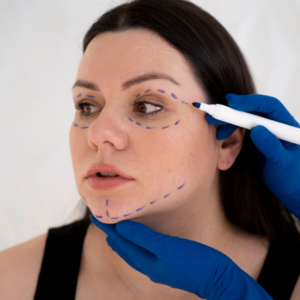
What are Dermal Fillers?
Dermal Fillers are injections that are used to restore the lost volume in the skin, smooth ot wrinkles, and enhance the facial features. It is an FDA-approved, minimally invasive procedure that effortlessly enhances your facial features and makes you look younger and attractive. There are different types of fillers for different aesthetic purposes.
Whether you want to remove the soft lines, add definition to your lips or jawline, or restore column to hollow areas, dermal filler provides instant results without any surgery. The procedure is quick and requires no downtime. However, this procedure is a temporary solution that can last 6-18 months.
What Can Dermal Fillers Treat?
As we age, collagen production starts to decline in our bodies due to stress, aging, and other environmental factors. This leads to fine lines, wrinkles, volume loss, and saggy skin. Our skin loses its elasticity and starts to sag. Dermal filler can significantly enhance different areas of the face, such as:
- Add volume, shape, and definition on the lips
- Restore lost volume on cheeks and lift the sagging skin
- Smooth out the deep laugh lines around the nasolobial folds
- Reduce lines around the mouth
- Minimizes dark circles and wrinkles around the eyes.
- Define and contour the jawline and chin
- Correct minor bumps and asymmetry of nose
- Smooth out the texture of hands and neck
Types of Dermal Fillers
There are different types of dermal filler, each addressing a specific skin condition. For instance, some fillers can remove wrinkles, while others add volume to your skin and enhance its elasticity. The most popular filler is hyaluronic acid, which adds volume to your skin and keeps it hydrated. The types of fillers are:
Hyaluronic Acid (HA) Fillers: Hyaluronic acid (HA) is a naturally occurring substance in the skin that helps maintain hydration, plumpness, and elasticity. HA fillers are the most common and safest type of fillers for lips, cheeks, smile lines, jawline, under eyes, and hydration. They add volume and keep your skin hydrated.
Calcium Hydroxylapatite (CaHA) Fillers: CaHA fillers contain tiny calcium particles that stimulate the collagen production in your skin. These fillers are thicker than HA fillers and are used to treat deep wrinkles and for contouring. They add immediate volume and stimulate collagen production in the skin. Additionally, they last longer than HA fillers.
Poly-L-Lactic Acid (PLLA) Fillers: PLLA fillers are biodegradable and stimulate the natural production of collagen in the skin. They add facial volume and treat deep wrinkles. However, they require multiple sessions. These fillers are ideal for hollow cheeks, temple areas, and deep wrinkles. They last 2-3 years.
Polymethyl Methacrylate (PMMA) Fillers: PMMA filler consists of tiny microspheres that remain in the skin permanently and provide long-lasting filling effects. They also stimulate collagen production and treat deep wrinkles and scars. These are best for smile lines and acne scars. What’s more, they last longer than any fillers and are considered permanent.
Autologous Fat Transfer (Fat Grafting): This is a natural filler in which the healthcare provider removes fats from one body part and injects it into the face to restore its volume. These fillers are permanent and best for cheeks, lips, under eyes, and temples.
Which Dermal Filler Is Right for You?
You can consult with your healthcare provider to review the types of fillers and their purposes. Carefully explain your needs, expectations, and goals to them to choose the right filler for your skin.
Procedure Details
This procedure is quick, safe, and minimally invasive, with instant results. The entire procedure usually takes 30-45 minutes and requires little to no downtime. Before you get the procedure, you’ll need to consult with your doctor to assess your facial structure, skin conditions, and possible allergies. During your consultation, you can discuss your aesthetic goals and expectations. Your doctor will recommend the right type of filler based on your needs and skin conditions. He will also explain the procedure, expected result, and aftercare.
After consultation, you can get the fillers at the clinic. Before the procedure, your doctor will clean and disinfect the area to prevent infection. Then, he will apply a numbing cream to prevent discomfort in sensitive areas like lips. Afterward, he will inject the filler with the help of dermla filler or blunt tipped cnulla. He will inject several injections to make the necessary adjustment. After that, you will get the aftercare instructions to ensure a smooth recovery.